【Roundtable Discussion】Computational Materials Science Led by CMSI:Achievements in Advancing the Field and Next Steps
 The computational materials science straddles the fields of condensed matter physics, molecular science, and materials science. CMSI has promoted various activities (Fig. in the next page) to advance the new horizons of computational materials science in the past three and a half years. We spoke to some of the people who have worked to advance the field from various positions, asking them to reflect on their activities and achievements up to now and to tell us about the next steps for the coming “Post-K” era.
The computational materials science straddles the fields of condensed matter physics, molecular science, and materials science. CMSI has promoted various activities (Fig. in the next page) to advance the new horizons of computational materials science in the past three and a half years. We spoke to some of the people who have worked to advance the field from various positions, asking them to reflect on their activities and achievements up to now and to tell us about the next steps for the coming “Post-K” era.
Participants:
Chioko Kaneta / Expert, Fujitsu Laboratories Ltd.
Toshihiro Kawakatsu / Professor, Graduate School of Science,Tohoku University
Kengo Nakajima / Professor, Information Technology Center, The University of Tokyo
Nobuyuki Matubayasi / Professor, Graduate School of Engineering Science, Osaka University
Moderator:
Synge Todo / Associate Professor, Graduate School of Science, The University of Tokyo
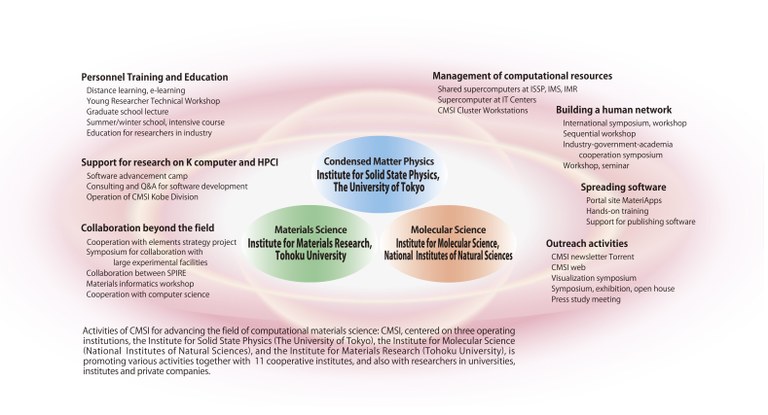
“Shared awareness of issues”- the watchword for industry-government-academic collaboration
todo(moderator): First, I'd like you to introduce your selve sand briefly describe what type of activities you've been involved in at CMSI.
Kaneta: My name is Chioko Kaneta, and I'm a researcher at Fujitsu Laboratories Ltd. I'm on the Industry-government-academia Cooperation Committee. We locate points of contact for industry, government and academia and hold workshops to promote collaboration. These are held several times a year, and I've been in charge of planning several of them.
Nakajima: My name is Kengo Nakajima. I am a faculty member of the Information Technology Center, the University of Tokyo (ITC/U.Tokyo). I'm in charge of operating the supercomputer system at the Center. I'm also a member of CMSI Supercomputer Cooperation Committee, and many of CMSI researchers are using our supercomputer system (FUJITSU PRIMEHPC FX10). Moreover, I have given some lectures in seminars and summer school for young researchers organized by CMSI. My specialty is parallel numerical algorithms. We are also providing tutorials for parallel programming with hands-on sessions at ITC/U.Tokyo.
Kawakatsu: My name is Toshihiro Kawakatsu, and I'm a professor at Tohoku University. I belong to the Personnel Training and Education Committee. There is a center of education in the Faculty of Science at Tohoku University, and as the head of that center, I administer teaching programs in cooperation with the Computational Materials Research Initiative(CMRI) located within the Institute for Materials Research. During the last fiscal year and this fiscal year, we held a series of seminars on Multi-scale Materials Science. Each year we hold a workshop designed for company and university researchers on OCTA, a polymer materials design simulation software program. We invite the members of the OCTA development team to give lectures and hold practicums. The participants are either half-half from universities and companies, or two-to-one from companies.
Matubayasi: My name is Nobuyuki Matubayasi, and I'm a professor at Osaka University. My specialty is molecular science, and I'm studying the use of computational statistical mechanics for molecular aggregate systems. I'm focusing on the common functions in the various types of molecular aggregates. My goal is to develop a universal software program to analyze these functions and help to popularize the program as something that could help a lot of people.
Todo: Thank you. I'm the Chair of the Publicity Committee, and I'm involved in putting together Torrent and the CMSI website. Recently, I've been working to spread CMSI application software through developing MateriApps, a portal site for materials science simulation software. I'm also working on collaborations and exchanges with AICS (RIKEN Advanced Institute for Computational Science).
I'd like to begin with the topic of collaboration on the part of industry, government and academia. What do you think has changed as a result of CMSI activities? Also, in what ways do you think we've been successful, and in what ways do you think we're just going around in circles?
Kaneta: At the workshops I mentioned, sometimes the university people weren't interested in the presentations by people in industry. People in the sciences start with an interest in “why.” People in industry first want to know “how.” The points that they're interested in are different, so I really felt that there
was a huge gap.
It's difficult to form a straight connection between people in the sciences and people in industry, so first we should work to form a connection to engineering. Also, I think one of the final forms of the ideal collaboration between industry and academia might be training personnel and sending them to industry.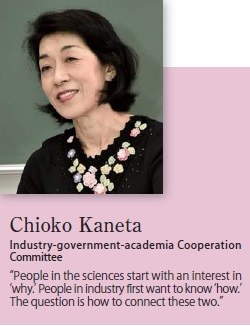
Todo: But even at CMSI, don't people in the materials field have very close relationships with the people in companies?
Kaneta: It's true that there are a lot of university laboratories that do contract research from private companies. But when you consider dissemination and penetration in the industries of the future, university laboratories can't cover it all, and besides it would be difficult for them to synchronize their efforts with industry trends. With only that, collaboration will wither away. So we should encourage undergraduate and graduate students who major in computational science to join companies and pile up achievements there, and that would stimulate the private companies. Then the benefits could flow back to the university. I think that unless we create a large movement like that, there will be no growth of the field as a whole.
Todo: Prof. Kawakatsu, you're involved in the development of OCTA. It was developed through collaboration between industry and academia, wasn't it?
Kawakatsu: Yes, OCTA was a project when I was at Nagoya University. People
from more than 20 private companies gathered at a research institute at Nagoya University and developed the software. Only a few university people were involved. The software that was created was released publicly, free of charge, and it's now used by many people at both companies and universities, not only
in Japan but in other countries as well.
Todo: What was the key to the success of OCTA?
Kawakatsu: I think it's the fact that they made all of the software free, and the fact that even now, after more than 10 years, the original members of the development team volunteer their time to improve the program. Its commercial version has been released as well by JSOL Corporation.
Kaneta: Yes, in the case of the most successful software that's been developed in other countries, it takes two or three decades before people come to use it, and people continue to improve it during that time, and there are user groups as well. Up to now, there haven't been any examples like that in Japan.
Todo: In that sense, OCTA is quite different from the other software that has been developed by academia.
Kawakatsu: A lot of companies use OCTA. But not many students use it. That's because students in the science departments prefer to create their own software.
Todo: Even if you've written the code, it's a lot of work to release something publicly and get everyone to use it.
Kawakatsu: You also have to write a manual.
Todo: At CMSI, we develop and improve a lot of software programs, and we want to make sure the best ones survive. What should CMSI do to accomplish this? Prof.Matubayasi, you're currently developing an application, and you're actually working with a company to try to expand its use. How does it feel to do that?
Matubayasi: I think they're happy with what we've done. We were talking about science a moment ago, and the good thing about science is that, even if there are various problems at each company, they are often seen as different faces of common problems. Science is there to provide approaches to those common problems. Even among companies in a different field of industry, it often happens that we're able to “translate” things into the same problems. If we do that, the program will come together as a single piece of software.
Todo: In terms of sending people to industry, I think computer companies conduct a lot of exchanges of that type, but what kind of efforts and arrangements are being made by universities? Prof. Nakajima, how do you view the fields of physics and chemistry, where supposedly there hasn't been much progress in personnel exchanges?
Nakajima: Generally speaking, research in computer science, especially in HPC(high-performance computing), should be practical. Therefore, it is rather easier for researchers in academia and in industry to share same type of awareness for future direction. This is the reason why information exchange and collaboration between academia and industry go well in the field of HPC. Moreover, many faculty members of Japanese universities in this area have experiences in industry. Recently, various types of choices for career-path's after graduation can be considered. Many students of our university want to join Google. Topics and methods for research in HPC are not so different between academia and industry. Thus, information exchange and collaboration between academia an industry are conducted very smoothly.
Training people who can create software, use software and tweak software
Todo: A shared awareness of issues on the part of industry and academia is something that needs to be cultivated in people starting from their graduate school days. At CMSI, we've tried to do this in the form of a series of workshops.
Kaneta: Universities do not exist solely for the benefit of industry. It is expected that academia basically aim for research that is at a high level. You don't need to answer all things what industry wants. I think it's only natural that each entity has its own approach.
Kawakatsu: If that's the case, then the Personnel Training and Education Committee only needs to cultivate students.
Kaneta: That's not what I mean. I just don't think that it would be good for everything to be facing in the same direction. For example, you don't gain the ability to create something simply because you understand the properties of a material. You have to go through an engineering process in which various materials are combined with one another to get products finally. And you also need competent people at the point between the basic and applied stages. So the question is how to train such people.
Matubayasi: It will be difficult unless those people in the middle are highly competent and hold a very high position. They have to be able to look at the basic research and conclude “We can use this, so let's put it over here” or “This is where we really need application personnel. There's something missing here, so we have to do something.” And they need to be in a position to say “Do this.” So it's not personnel training so much as cultivating true elites, right?
Kaneta: I think there are a lot of things that can be done at the engineer level as well, though that's not easy. Unless those things are done, I don't think there will be a true connection.
Nakajima: What kind of activity is expected to be done by academia for that ? Activities to promote the use of software on the part of the general public? Or building in things to make the software easy to use?
Kaneta: It depends on what value you see in those things. From a university professor's perspective, it's possible that activities to spread software would become just another chore to be done.
Todo: There's one more aspect. The population of people majoring in computational science has increased. Not all of them are capable of doing research, but we need to cultivate more and more people who go to industry and people who become those people in the middle. Various levels will be created ? for example, some people will develop applications, and people who have the expertise to do something using those applications will go to industry and do some kind of work in company research & development and so on. At CMSI, the Division Researcher system hasbeen established, and researchers work on various research projects to develop programs that are common to all fields. And they also work on activities to increase application use. The goal will be to cultivate people who can be in that middle position.
Nakajima: How about the career-path's of these people ?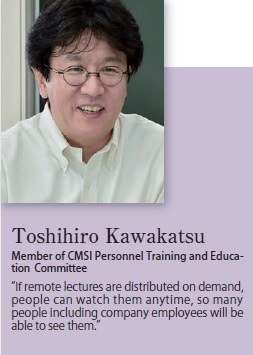
Matubayasi: If we create organizations that are like semipublic corporations and get private companies to contribute to them as well, and if we can get people to recognize that there is real value in joining those entities, I think that will become a good career path.
Kaneta: But even if companies are looking for people in the simulation field to work on materials development, they're not looking for application developers; they're looking for experienced users. It would be a plus if they could write short amounts of code to analyze the simulation results and so on, but there are almost no companies that write applications on their own. If there's a good application, they bring it in. What they need is talented people who can use various a pplications and hardware to solve problems in materials development and device development. Do you think universities are successfully training experienced users?
Kawakatsu: Maybe not.
Nakajima: I've also studied how to train computer science personnel at the university. We divide the people to be trained into three categories: 1st category is the people who can use computers and application programs, 2nd is the people who can develop applications, and the 3rd category is a kind of ultimate personnel who can cover both of science and numerical algorithms. I think different course materials should be provided for each category of people. The 1st category will become the group of users of application programs.
Kawakatsu: Is it all right if application users don't understand the theory behind the application?
Nakajima: No, they need to do that. We're formulating a teaching program to ensure that the people who can use programs also study the minimum necessary theory and algorithms while they're at the university.
Kaneta: However, the programs right now are getting enormous. So rather than not allowing them to use the program until they've read every inch of it, it's good enough if they're able to study the things that they become curious about in the course of using the program.
Matubayasi: “This program produces these great results, so it must be backed by tremendous theory, so I'm going to study it.” I think that's the sequence that will ultimately be most efficient.
Todo: So what do you think should be taught to train people who can use programs?
Nakajima: Basically, it doesn't matter whether it's commercial code or a program that the professor teaching the class has made by himself or herself, the students should be taught to use it and be able to compute the various results accurately. It's also important to cultivate the sense that will enable them to evaluate the results ? in other words, an engineering sense. Moreover, they should also study the minimum necessary things related to computer science, so that while they're at the university they acquire enough knowledge to have a discussion with the people who develop applications. I think that will enable them to be quite successful as users.
Computer education in anticipation of the Post-K Supercomputer
Todo: I'd like to turn now to the issue of the Post-K Supercomputer, the succes or to the K computer. We need to educate people about a computer that will have 10 million cores. But the programs and applications that can be used on such a platform have not yet been developed. At CMSI, we're distributing a series of remote lectures by computer specialists like Prof. Nakajima and application developers. These have been very successful, and a lot of students have taken the course. But I'm worried about whether we can do this on a higher level in the future, up to the exascale level.
Matubayasi: Some of my students participated in those remote lectures, but many felt that it was quite difficult. I think it's unlikely to achieve its objectives with only one lecture a week. I think it will be difficult to make it effective unless you make participants gather and stay somewhere for a while and teach them intensively.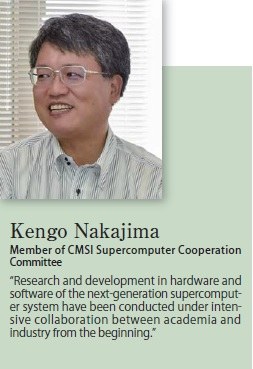
Todo: Through practicums?
Matubayasi: Through training.
Kawakatsu: I wonder if that will get students to attend.
Matubayasi: This may sound extreme, but you have to make them go to class whether they understand or not. They don't know which industry they'll be working in. So you need to get them to learn even just all of the essential terms and have them take home all of the references. The thinking should be that they may not understand the content now, but eventually the day will come when they'll look at those references.
Kaneta: It's true that it's important for them to remember when they hit a wall that “oh, that's right, I remember getting a reference for that.”
Matubayasi: Another point is that when the Post-K Supercomputer becomes a reality, I think training people who can be involved in the programming for that computer will be a separate issue. They'll have to actually fine-tune the thing, so it won't be a matter of lecture learning.
Todo: AICS holds an HPC Summer School every year. Is that for graduate students?
Nakajima: We have a lot of graduate students, but there are some post-doctoral researchers as well. The content is very basic. First we aim at a level that enables them to be able to understand and to program to some degree using the Message Passing Interface (MPI) protocol. The summer school is held for five days, but we don't just try to teach everything about parallel programming in a haphazard manner. We establish a target application and teach the techniques needed to parallelize that application. In our experience up to now, that's more effective as a short-term teaching program. Currently we're covering issues relating to th ee-dimensional steady-state heat transfer using the finite element method. However, some people don't know anything about the finite element method, so the first day's lectures cover the finite element method itself and its programming. Next we cover the MPI needed for the parallel finite element method. Then we talk about actual parallelization. Finally, we also cover OpenMP and give the students an entry-level knowledge of hybrid parallel programming. That concludes the fiveday course. We cover a lot of content, but this year we were able to secure about two hours of practice time each day. I think if the students spend that amount of time, they'll understand not only in theory but to some degree they'll have had the experience of programming for themselves, and that will stay with them. We haven't received any feedback yet, so I don't know how it was received by the students in the program. But they all worked very hard, all the way through to the end, so I think this year's approach was comparatively successful. If you spend a solid week intensively doing something, you retain a lot.
Todo: I feel that that type of education is pretty general, so rather than CMSI doing it, having it done by AICS or by the Information Technology Center and then having other institutions offer other types of education might be better. Prof. Nakajima, from your perspective, how much content and how much time should the ideal computer education have in order to create the ideal program for training computer scientists?
Nakajima: The most important thing is to train intermediate people, which are the 3rd category of people mentioned a moment ago, and make them people who can become a bridge between various fields. But in some ways it's difficult to do that in education. A lot of different programs are being tried. For example, some universities are having students major in physics and also assigning another academic advisor from the computer science field. One possibility is a dual degree program of Ph.D in science and M.S in computer science with 3-4 years. To begin with, we can put in place those kind of programs on the university side. When it comes to intermediate personnel who can be useful in the real world, it would be difficult unless they first get some degree of practical work experience. In that sense, collaboration between industry and academia will be important.
Todo: By practical work experience, do you mean actually doing development and research at a company?
Nakajima: Yes, that kind of thing. I think training people who can meet a variety of needs isn't something that can be done at the university alone.
Kaneta: If you go into a company environment, you learn how applications are being used, and you see that there's a different attitude toward the awareness of issues. When a problem arises, the most important thing is time. You have a limited amount of time and limited resources, and you have to think how you can use those skillfully to resolve the problem ? if not 100%, then 80%. For that reason, you have to make a lot of judgment calls. Not just that “this program is good, so I'll use it” but that there may be other options, or that a certain application is not as precise, but it's fast, so it might be better to use that one, and so on. In that sense, we should train students not to learn just one application but so they're able to use at least two or three to some degree, and to train them so they're able to consider which one to use when a problem arises. That's what will really help them in an actual workplace setting.
Change of consciousness needed for CMSI and academia
Todo: A moment ago we talked about how people who are doing simulations in the sciences can't get hired by companies. Is there anything that CMSI can do to provide support?
Kaneta: Actually, people with a science background have a good grasp of the fundamentals, so they should do well wherever they go. But a lot of people don’t understand that.
Nakajima: So isn't creating opportunities where they can learn that the most important thing?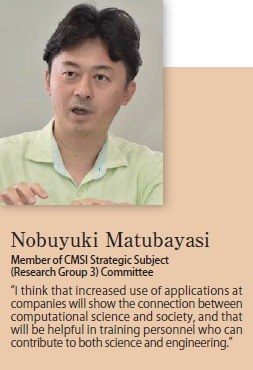
Kawakatsu: People who come out of sciences should try to do their best at their company.
Nakajima: That’s true as well.
Kaneta: More directly, I think it would also be possible to produce results in simulations of hot topics in the materials field and present them with a big splash, not at academic society meetings that corporate people will never attend, but at places where people from corporations will go, in order to promote those individuals in a strategic manner.
Matubayasi: So we should not only hold presentations that show “these are the things we're doing at CMSI, so you should come” but also go to places where corporate people gather and hold lecture meetings and presentations.
Kawakatsu: It's true that physics students usually try to go to physics association meetings, but they're afraid of academic society meetings and workshops where there are a lot of corporate types, so they tend not to go to those.
Todo: So professors need to be educated as well. The dream of industry-academia collaboration will wither away unless we change the consciousness and make a steady effort. And we also need to teach students how to tie a necktie and the proper way to present a name card.
Kaneta: Unless we expand the base, ultimately we won't be able to secure research budgets, either. So if we're thinking about the future, it's something we should definitely do.
Todo: In terms of strategic programs, up to now we've pursued twin tracks simultaneously the study of research issues and advancement of the field. But the study of issues in preparation for the Post-K Supercomputer is scheduled to begin in the latter half of this year. On the other hand, it's not yet clear in what form projects for activities to advance the field will continue.
Nakajima: More large-scale computers and research into algorithms will both be important issues for the achievement of the Post-K Supercomputer. Cooperation between individual fields extending across industry, government and academia will be essential. I hope that is promoted at CMSI as well.
Kaneta: A lot of application programs have been developed, but I'm really worried what will become of them once the project ends. As a mechanism for preserving
the good ones, I think if we build a platform that would allow programs with different hierarchies to be linked and used in combination with one another, it would make it easier for them to be used in industry as well.
Todo: The big question is who's going to do that.
Kawakatsu: It would only be necessary to build a common platform and format and make it possible for people to link to them and use them.
Todo: There's also the question of what to do with simulation results. Because the output is incompatible with various platforms.
Kawakatsu: The common format will help with that as well.
Kaneta: The national budget is such that, even if you can get money to build a new application, there's not enough to nurture it from that point on. You need to make your request very loudly.
Matubayasi: It might be more effective if industry makes the request instead of a university professor, saying things like “This is an industry need” or “Industry will suffer if we don't cultivate this.”
Nakajima: The JST (Japan Agency for Science and Technology) has an industrial applications framework that can apparently be used for ongoing support of things that have been researched and developed.
Matubayasi: I think that should be the role of university-affiliated research institutions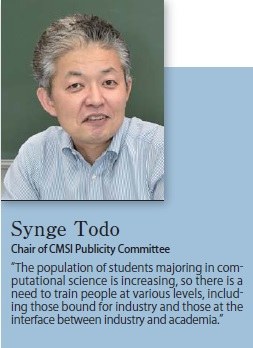
Todo: At CMSI, there's currently a perception that the Institute for Solid State Physics and Institute for Molecular Science are for joint use within academia only, and it's difficult for corporate people to get in. A change of consciousness is needed.
Matubayasi: I agree. We have the space, so we should also have people from various companies come in to enable daily exchanges. If we put the university research centers on the first, third and fifth floors and used the second and fourth floors as space that we could lease to various companies, it would be ideal.
Todo: I think the role of affiliated research institutions is going to change greatly in some ways in the next five-year plan. I think they should not handle only administration and leasing of machines; they should play a role in providing various kinds of support. A change of consciousness will be needed to achieve that. You could say that, in preparation for the Post-K Exascale Supercomputer, a change of consciousness is needed not only at CMSI but throughout academia in Japan.
(Recorded September 5,2014 at Hongo Campus, The University of Tokyo)
Photography cooperation: Information Technology Center, The University of Tokyo
Text : Sakiko Fukushima Photos : Shuich Yuri

